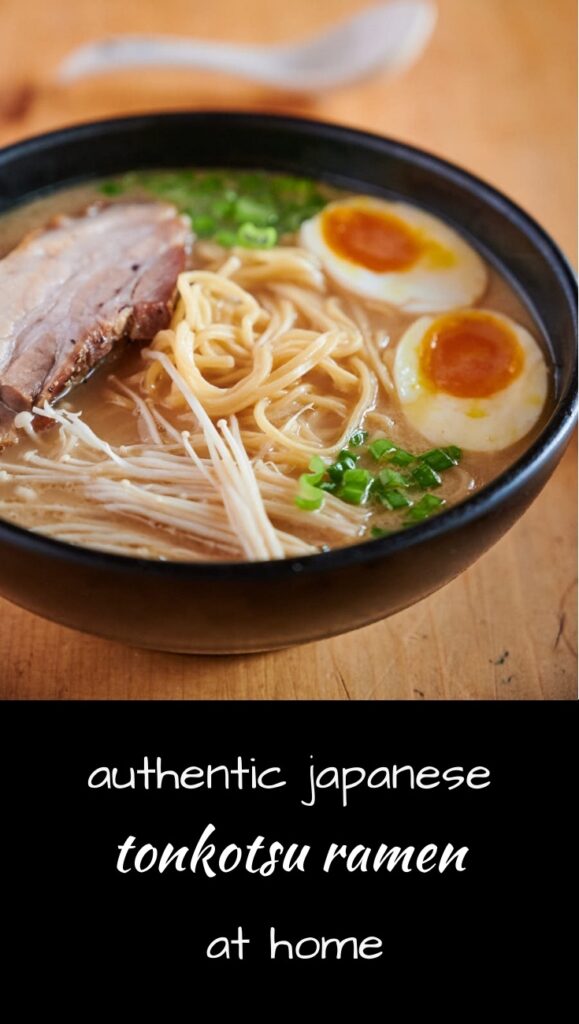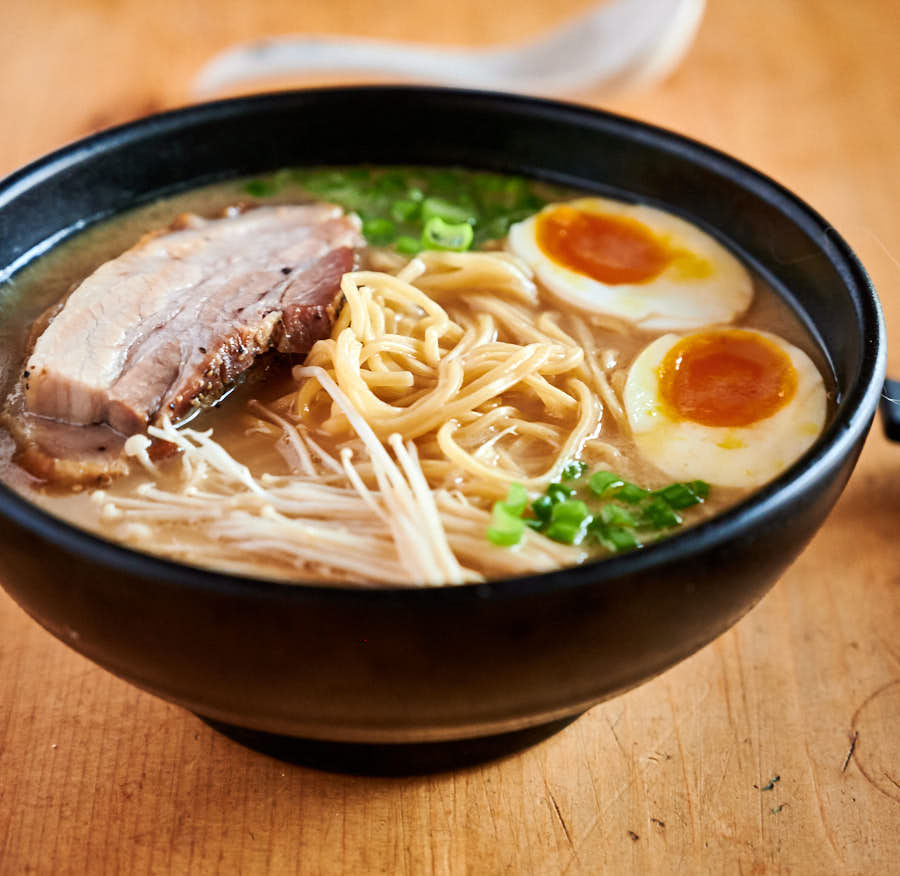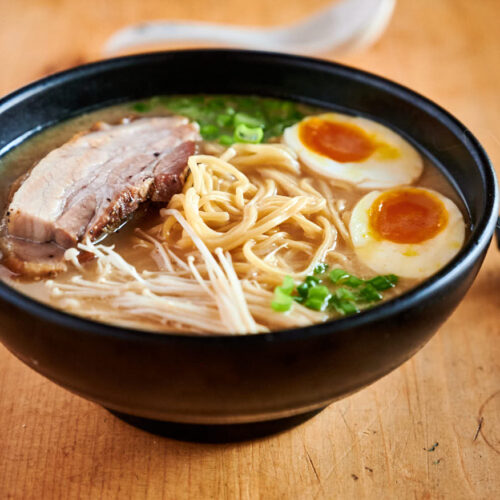Making tonkotsu ramen at home is truly a labour of love. This isn’t some 15 minute miracle insta-ramen recipe. This isn’t even some one day recipe.
Making authentic tonkotsu ramen takes time. It takes effort. You have to be a bit crazy to go there. But it’s so good. It’s totally worth it.
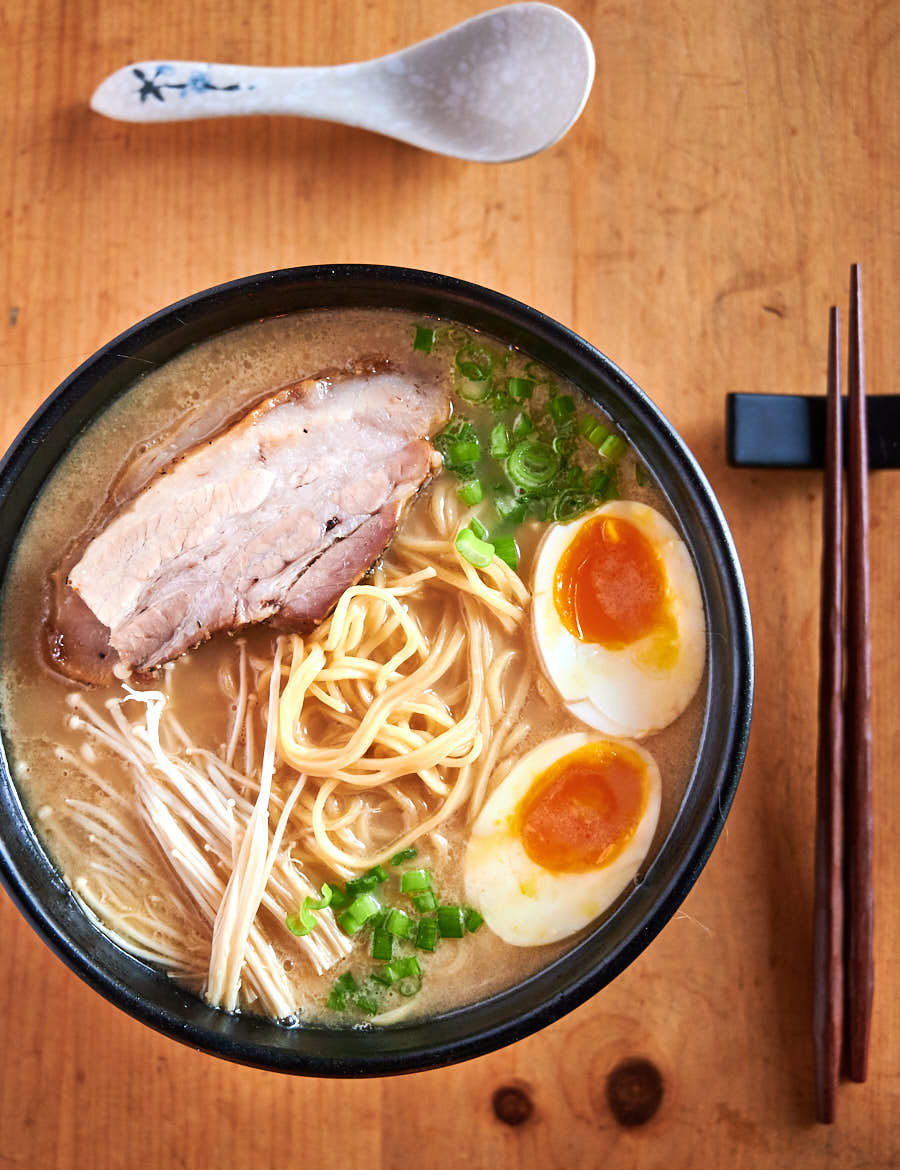
There are restaurants in Japan that do nothing but make tonkotsu ramen. Just big wonderful pots of the most amazing broth.
Perfect noodles. Silky eggs and unbelievable pork. I’ve had it. And I love it.
This recipe may not quite hit the level of Japanese ramen making. People have devoted their whole lives to mastering the art.
But it’s pretty damn good. And it’s way cheaper than a plane ticket to Narita.
There are five major ingredients
Tonkotsu ramen has five major ingredients. Broth. Noodles. Pork. Egg. Tare. Each is important and each takes some doing.
Tonkotsu broth is the heart and soul of any tonkotsu ramen. It’s not difficult but it takes time – 12 to 18 hours. Mostly unattended but you can’t rush this.
You can make lots and freeze it though. Two bowls or twenty. Doesn’t matter at all as long as you have a big enough pot.
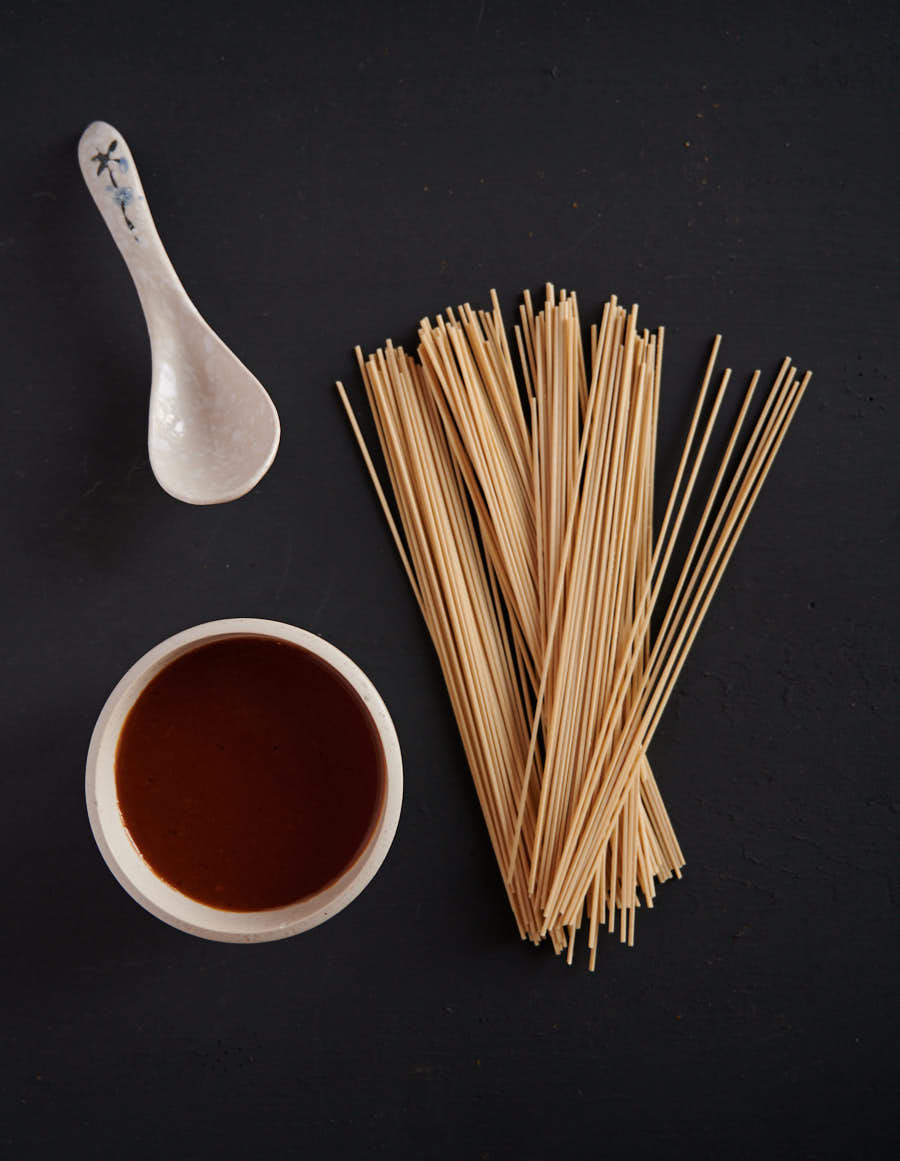
The noodles are key
The noodles are the backbone. Noodles were where I struggled the most. The fresh ramen I can get in town sucks. Like really sucks.
Ramen noodles are different. They are alkalinated. That’s a fancy way of saying you put baking soda in the dough.
Asian stores sell dried Japanese ramen. Look for sodium carbonate or potassium carbonate in the ingredient list.
If you can’t find any, another trick is to boil spaghettini or capellini in 8 cups of water with 2 Tbsp of baking soda. That works too.
Please don’t use packaged dry instant ramen noodles. Those are completely different.
I like them in an I like KFC sort of way (as in I eat it once every few years and then wonder why I did that) but for this they are so wrong…
The pork is called chashu. It’s marinated pork belly and it’s magic stuff. I do mine sous vide for 11 hours at 170F. Conventionally cooked chashu recipes are all over the internet.
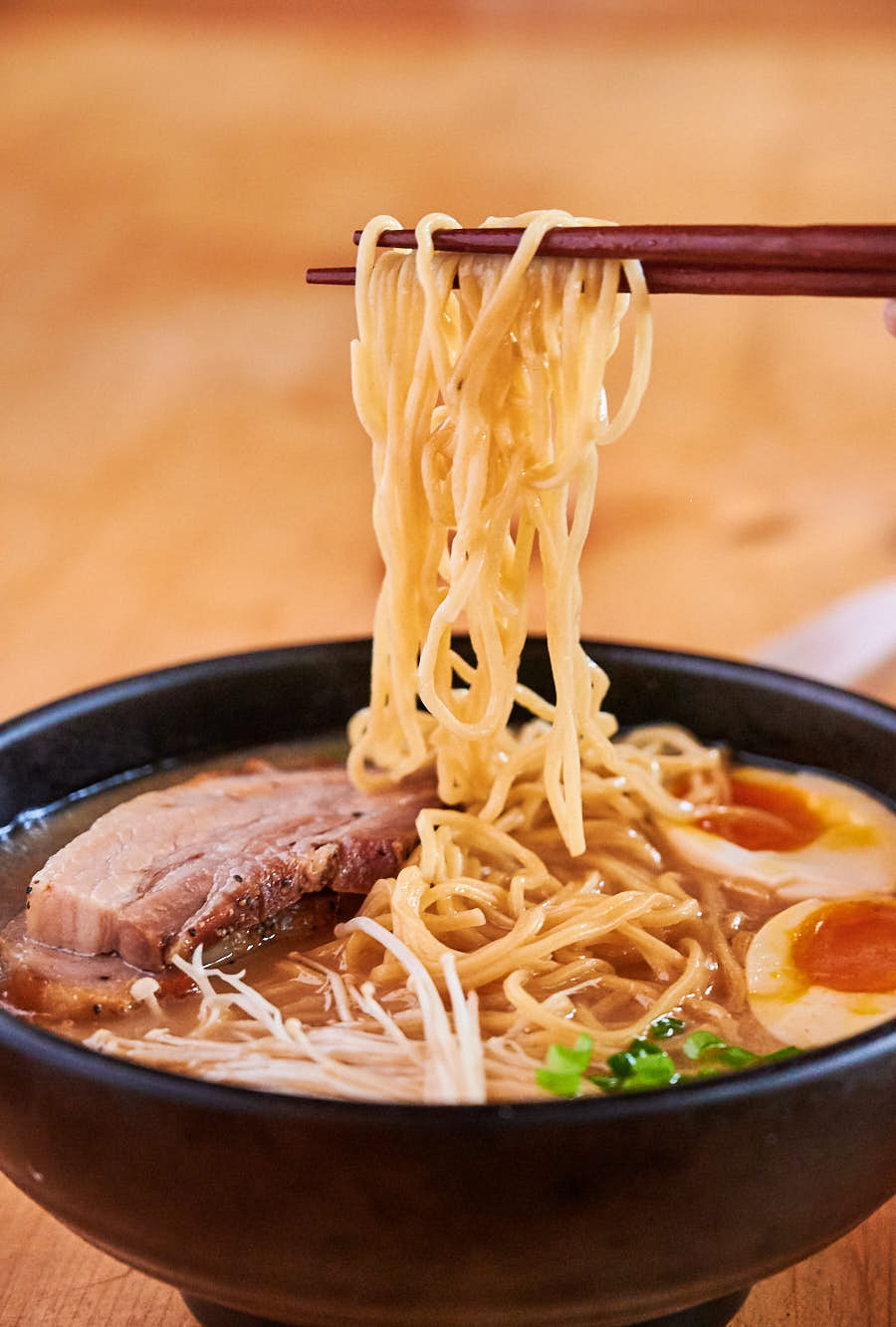
The eggs and the seasoning
Tonkotsu ramen is usually served with medium boiled eggs. I didn’t even know there was such a thing as medium boiled egg until I discovered ramen.
Medium boiled is about a 7 minute egg. The whites are firm. The yolk are just barely set. Just so good.
The tare is the flavour base. This is where you take your ramen in your direction. It can be as simple as salt or as complicated as bacon infused sweet soy miso tare. Up to you.
Pull these 5 elements together and you have wonder in a bowl. If you don’t understand why you’re reading this and think I’m crazy google the best ramen joint in your town.
Go taste for yourself. Then judge me. It may seem daunting but it’s a few manageable steps. Totally doable if you want it bad enough.
This is adapted from several recipes from the internet. The soy bacon tare is a based on David Chang’s Momofuku Tare 2.0.
The chashu pork marinade is from Serious Eats. The tonkotsu ramen broth is the best of a bunch of recipes on the net.
Tonkotsu ramen. It’s real work. But it is so worth it.
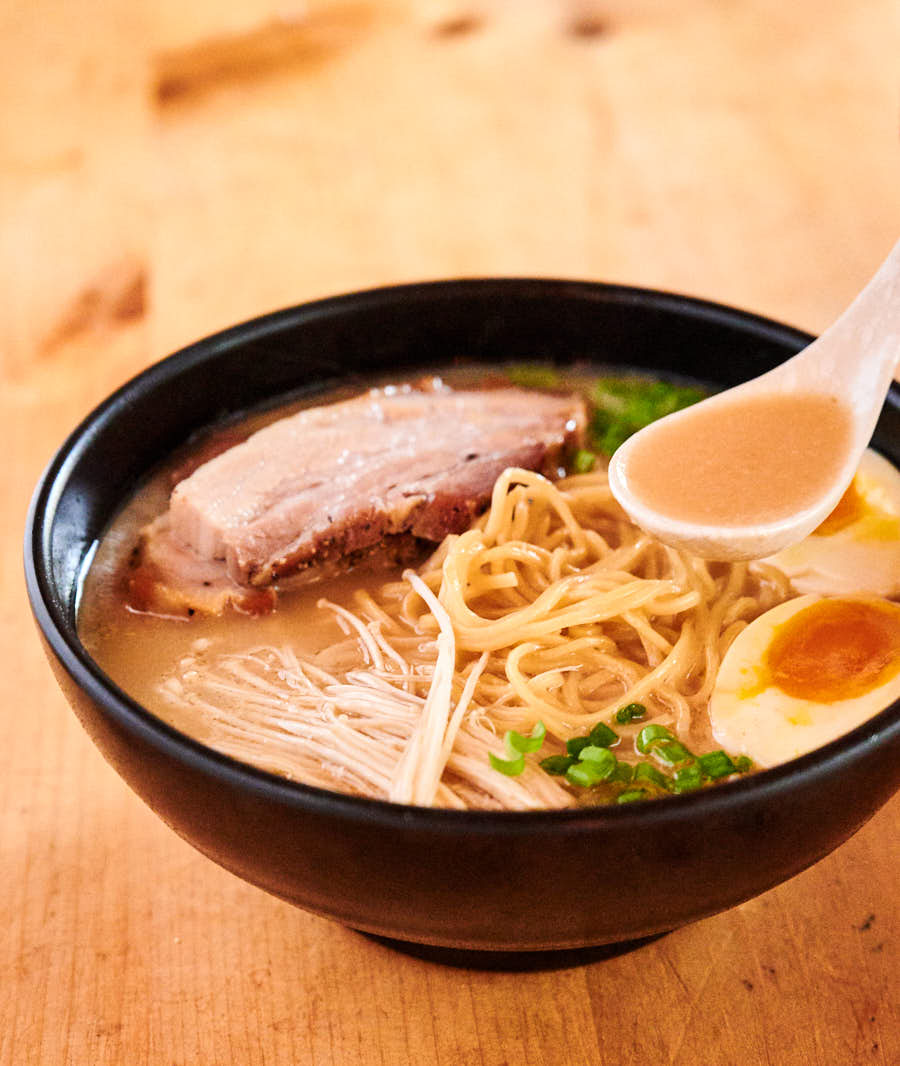
Update: Since I wrote this post I learned how to make Momofuku pork belly. If you’re interested I actually got a lesson in the kitchen at Momofuku Las Vegas. So I’m pretty sure it’s the real deal.
I still love the sous vide chashu pork belly and make it regularly. But the Momofuku pork belly is really good too. And you don’t need a sous vide to make it.
I’ve taken new pictures since this was first published. The new pictures have the Momofuku pork belly in them.
So if you make chashu pork don’t be alarmed if it looks different. It is different. I cannot decide which one I like better.

tonkotsu ramen
Ingredients
Tonkotsu ramen
- 8 cups tonkotsu pork broth – recipe link below
- 12 oz good quality dried ramen noodles
- 4 large or extra large eggs
- 2-3 oz enoki or other mushrooms
- thinly sliced green onions
Chashu pork belly
- 2 lb pork belly – rolled and tied
- 1/4 cup soy sauce
- 1/2 cup sake
- 1/2 cup mirin – sweet Japanese wine
- 1/4 cup sugar
- 2-3 cloves garlic – left whole
- 2 green onions – coarsely chopped
Soy bacon tare
- 2 slices bacon – use good quality bacon here
- 1/4 cup soy sauce
- 2 Tbsp mirin
- 2 Tbsp sake
- 4 Tbsp shiro miso
Miso Tare
- 1/2 cup shiro miso
- 1/4 cup sake
- 1/4 cup mirin
- pinch shichimi togarashi (optional)
- 1-2 tsp kosher salt – depending on how salty you like your ramen.
Instructions
Chashu pork belly
- Combine the soy, sake, mirin, sugar, garlic and green onions in a ziploc bag large enough to hold the pork belly. Stick a straw in the bag and seal the ziploc bag up against it (so the straw is the only opening). Suck as much of the air out as you can and seal.
- Sous vide the pork for 10-11 hours at 170F.
- Remove pork from the ziploc bag. Discard the bag and marinade.
- Let the chashu pork belly cool completely.
- Slice across the chashu pork (so you get bacon like slices) – into 8-12 slices about 1/8 to 3/16 inches thick. Reserve. You won’t need all the pork for 4 servings.
Soy bacon tare
- Combine all the ingredients in a small sauce pan. Simmer at the lowest setting for about an hour. Top up with a bit of chicken stock if needed.
- Remove the bacon.
Miso tare
- Combine all ingredients in a small sauce pan and simmer at the lowest setting for about 5 minutes.
Medium boiled eggs
- Bring enough water to cover the eggs to a boil. If you have a way to prick the eggshell do it. Boil large eggs for 6 minutes 30 seconds. If using extra large eggs boil them for 7 minutes 30 seconds. You may have to adjust your times slightly depending on the exact size of your eggs but this should get you pretty close.
- Submerge the eggs in cold or ice water to chill. This stops the egg yolks from continuing to set up. Peel. Cut in half right before you serve your tonkotsu ramen.
Assemble the tonkotsu ramen
- Boil the ramen noodles in plenty of water as directed by the packaging. If there’s no translation on the packaging usually its 4 minutes. You don’t need to salt the water.
- Cook the mushrooms along side the noodles – you just want them softened.
- Gently fry the chashu pork in a non-stick skillet until lightly browned.
- Place 1/4 of whichever tare you are using in the bottom of four bowls.
- Ladle in about 1/2 cup of the tonkotsu broth into each of the bowls and stir to mix.
- Add the noodles. Pour in another 1 1/2 cups of the tonkotsu broth per bowl.
- Top with the egg, mushrooms, pork and green onions.
Notes
Nutrition
